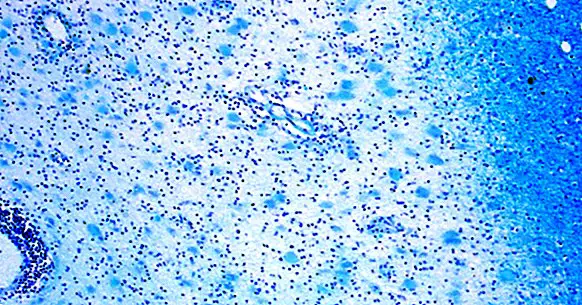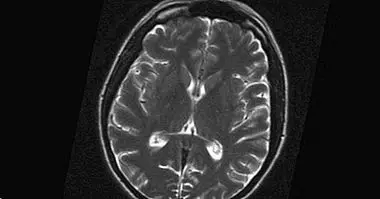The 15 most common nervous system diseases
When we talk about the nervous system, we usually think about the brain , and that is indeed one of the most important elements that constitute it.
However, the brain alone would be unable to interact and control the different organs and allow us to move and perform behaviors that facilitate our adaptation, or even survival, if there was not an entire system dedicated to it. We are talking about the whole nervous system.
Its correct functioning is vital for the human being. However, there are different disorders and diseases that can jeopardize its proper functioning and limit our capabilities to a great extent, and even cause death. Therefore, in this article we are going to talk about different types of diseases of the nervous system .
- Related article: "The 12 most important brain diseases"
Diseases of the nervous system
There are a lot of disorders and diseases that affect the nervous system.
Although those diseases that affect the brain and the cerebellum can also be considered as such, in this article we will try to focus on those that cause an effect on the nervous system as a whole, both at the central and peripheral nervous system level .
1. Epilepsy
Epilepsy is a disorder caused by hyperactivation of certain neuronal groups which for some reason are hypersensitized , and before a minimum activation they react abnormally producing diverse symptoms like the typical convulsions (although these only happen in the case of the crises of great evil), loss of conscience, incoordination and lack of control of the muscles and viscera, slowness and weakness.
- Related article: "Epilepsy: definition, causes, diagnosis and treatment"
2. Tumors
There are a lot of tumors that can affect the nervous system, whether they originate in it or if it is affected by the metastasis of a cancer in another part of the body. Within these tumors we can find astrocytomas, glioblastomas, gliomas, meningiomas or medulloblastomas, among others.
The damages are caused both by cell proliferation and by breaking synaptic connections or the compression of neurons against other structures.
3. Enclosure syndrome
This strange syndrome has its origin in lesions of the brainstem or in the nervous connections. The subject is conscious but can not communicate or move due to the lack of nervous connection between the brain and other parts of the body.
4. Multiple sclerosis
Desmilinizing disorders are a group of disorders in which axons of neurons progressively lose the substance called myelin, which is very important at the time of transfer bioelectrical impulses through the nervous system .
This causes the body to lose little by little the ability to send messages efficiently to the body, producing symptoms such as muscle tension, weakness, pain and perceptual alterations.
- Maybe you're interested: "Multiple sclerosis: types, symptoms and possible causes"
5. Amyotrophic lateral sclerosis
In this disease there is a progressive deterioration of the motor cells of the nervous system, dying these little by little. Thus, with the passage of time the muscles stop receiving nerve impulses and end up atrophying. This prevents voluntary movement .
Also, as the disorder progresses it can eventually affect the heart and respiratory muscles and cause death.
6. Diabetic neuropathies and other metabolic disorders
The presence of metabolic disorders such as diabetes mellitus can cause severe damage to nerves and neurons throughout the body. The nerve fibers are damaged, in addition to blood vessels can not correctly direct the flow due to the incorrect metabolization of glucose.
In the case of diabetes , these problems are especially visible in the extremities, especially in the lower ones. It can also affect organs such as the eyes or even the heart.
7. Infections
Infectious diseases can greatly affect the set of neurons and structures that make up the nervous system. HIV and untreated syphilis can alter and damage neurons . Also the herpes simplex virus, cytomegalovirus and rabies. Encephalitis, meningitis, immunodeficiency that facilitates the action of other viruses and necrosis and neuronal death are frequent.
8. Dementias
This type of nervous system diseases, especially localized in the brain, are characterized by a progressive degradation and loss of neurons and their normal functioning that causes the loss of different cognitive and motor skills.
Alzheimer's, Parkinson's or Huntington's disease they are diseases that entail or can entail (not all people with Parkinson's develop dementia as such, for example) the progressive deterioration of nerve fibers.
- Related article: "Types of dementia: forms of cognition loss"
9. Mononeuropathies
Injury to a peripheral nerve by various mechanisms, such as continued compression, the presence of infections or hemorrhages or sectioning.
10. Polyneuropathies
Inflammatory process of several nerves or nervous tracts that generate diversity of symptoms such as tingling or loss of control and sensitivity, muscle atrophy, weakness, diarrhea, erection disorder or cardiorespiratory disorders, among others.
11. Injuries and sectioning
While it is not about diseases per se, the presence of blows and injuries It can cause the nerves and neurons present in different parts of the body to be damaged and unable to perform their functions in a habitual manner.
You can lose the perception or control of muscle groups or even relevant organs. Depending on the type of injury can even cause a cardiac arrest and death.
12. Guillain-Barré syndrome and other autoimmune diseases
Some autoimmune diseases, such as Guillain-Barré syndrome, can cause that our immune system attack to the nerves of the nervous system, which damages them and makes it impossible or impossible to transmit nerve signals.
13. Autonomic dysreflexia
Disease caused by spinal cord injury and a hyperactivation of the autonomic nervous system, in addition to a spectacular and dangerous increase in blood pressure due to the difficulty of regulating blood pressure in the non-innervated areas, below the spinal cord injury.
14. Monoplegia, hemiplegia and tetraplegia
The sectioning or damage of nerve fibers of the nervous system can cause paralysis of specific body parts . This paralysis can occur at a specific point of the body (monoplegia), on one side of the body (hemiplegia) or even on the set of extremities (tetraplegia), making movement and even tactile perception of these areas impossible.
15. Neuralgia
Neuralgia is a group of diseases and disorders of the nervous system that they are characterized by the presence of pain derived from a malfunction , pinching or alteration of nerve pathways linked to the perception of pain.
Bibliographic references:
- Adams, R.D. (1997). Principles of Neurology. 6th edition. McGraw-Hill.
- Bannister, C, Tew, B. (1991). Current Concepts in Spina Bificla & Hydrocephalus. London: Mac Keith Press.



















